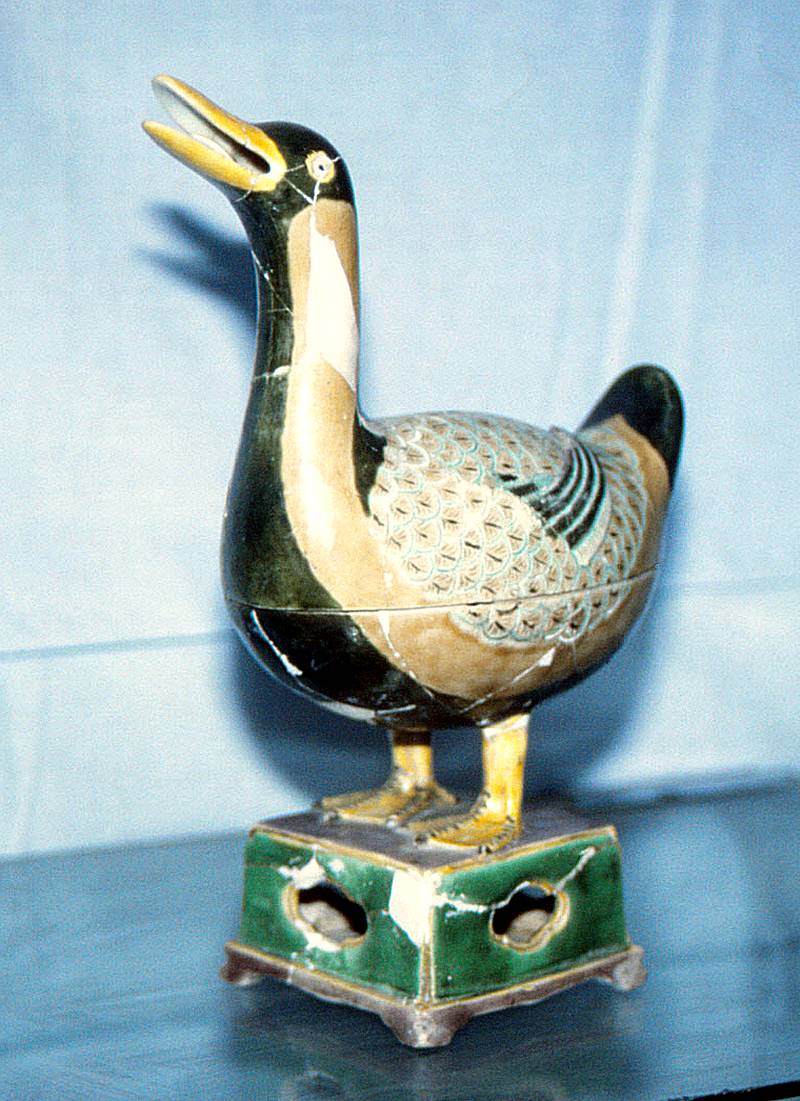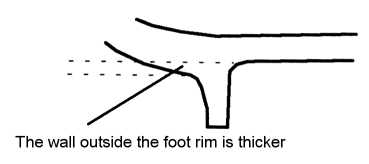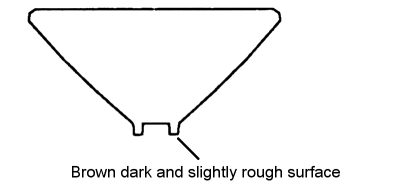
Chenghua copies (1465-87) of the Song (960-1279). A few observations:
Pale green craquelure celadon
Some cracks dark, others bright.
The foot rim brown, but it appears that the foot rim has been dressed in dark slip.
Same Chenghua mark as on one of the bases I photographed during my previous visit in 1991.

Fig. 8. Color sequence of foot rim, celadon ge glaze copy from Chenghua (1465-87).
The brown color of the foot rim is clearly dressed on afterwards and is in places covering celadon glace.

Fig. 9. Some shapes from Chenghua (1465-87)
They had found seven ducks on Zhushan; one had been exhibited at a special exhibition in Gugong in Beijing. We were not allowed to photograph any pieces from the Chenghua (1465-87) at all, this time, because of an agreement with Hong Kong where everything would be exhibited in 1993, and a book published. So I decided to draw all relevant observation and eventually match them with photos at a later occasion. The drawings are rendered below.

They had found seven ducks on Zhushan. Chengua period (1465-87).
This was as far as I can remember exhibited at the Longzhu pavilion and is not the one I drew. In particular I miss the vent holes.
An object they were particularly proud of was a water bottle in Persian style (Fig. 10). A similar from the 1200s had been found in Korea, they said, "Officials sent it to Korea". This shape is old but occurs in porcelain for the first time during the Chenghua (1465-87). A censer have iridescent brown glaze (fig. 11).

Fig. 10. Bottle of Persian shape, a censer with side handles and a tripod bowl. Chenghua period (1465-87).
The Celadon wares and the Persian bottle was found quite close to each other at the location of the former main entrance of the Imperial porcelain factory at Zhushan.
Chinese from Chenghua (1465-87), from Potang in the Leping area immediately south of Jingdezhen, they said. Prior to that it was imported from Persia. Last year (1991) cobalt came from Iraq.
Some observations: yellow, iron red, grass green, and blue as outline in underglaze blue. That this bowl was rejected might have been because the bottom has sunk some. Square seal mark. The body outside of the foot rim is thicker than inside. This may be a manufacturing defect. The foot rim thin, high and straight cut. You cannot say that it is softly rounded. Seal mark is dark blue, slightly blurry. Quite square, but not perfect. The blue in the upper edge rim flown out and uneven.
Some observations: Characteristic for these Chenghua period (1465-87) Doucai-objects is the pale blue tone of the enamels. The under glaze blue color is blurred even if the lines are thin. The color seems to go from light blue to dark bleed through without mid tones. The red is a special "bloody" red color. Based on iron but in thicker layers that here holds, for some reason. A flower was drawn by crosshatching. Seal marks occur with very thick outlines. The most notable is that it is impossible to determine exactly how the glaze was finished short of the foot rim. I've looked at so many examples on this now that I would definitely advise against to rate any object as Chenghua Guanyao if it is possible to determine exactly how the glaze is finished against the foot rim. It appears as if the foot rims was when finalizing the work was wiped with a cloth or chamois on larger items.
Regarding the nianhao it was understood that it would be in imitation of the the emperor's own handwriting. "Since the Chenghua period emperor was quite young when he ascended to the throne, his calligraphy was not perfected", they explained.
Some observations: For the altar of the Earth (yellow) : yellow dragons on a white background, with blue outlines.
Under glaze red dragon on white background.
White dragon on a red background.
Aubergine dragon on a yellow background.
Green dragon on a yellow background.
On a small wine cup one dragon was facing left, the other dragon frontally.
On the larger bowl with the underglaze red dragon on a white background, both dragons were
depicted in full figure.
I now saw a system in this and asked Jiang (Jiang Jianxin, Assistant Research Fellow) if there possible also was a bowl where Dragons were reproduced in white on red. It did, but I noticed that they for some reason had not expected this question. From Liu's book I eventually found out that this bowl was the only one known of its kind. No wonder we did not get to take any pictures. The little yellow dragon cup was Chenghua mark and period. The large ones I did not think of to check.

Fig. 11. Doucai bowl. Chenghua period (1465-87).

Fig. 12. Celadon copy. Chenghua period (1465-87)
We missed our travel companions from our visit last time. Jarl wrote the Chinese characters for "homesick" on a Chinese period chart. We sampled the hotel's, Whisky and Campari (not mixed) at the cost of 180 Yuan. The petite Chinese waitress looked suitable shocked. Jarl and I took a night time stroll in the still stifling hot misty night. We walked up to Jingdezhen Hotel China's main building that was of a more robust kind than our Guest House.
I had talked porcelain purchases with our interpreter who now called and asked for instructions.
We despair a little when it comes to getting a handle on minyao. Everything seems to have been made everywhere. Porcelain clay could then as now have been made locally by stone as a porcelain stone dealer delivered on the site that manufactured clay for the open market or in larger localities, Hutian, Jingdezhen and Yaoli, made everything up to finished goods. Everything could then be sold in a single market, which all competing to make bowls that were as similar as possible. During the evening we jotted in on the large province map the location of the two kilns we so far have visited.